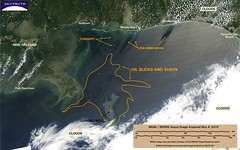Washington Post:
Last August, just two days into a research cruise to study methane gas spewed into the Gulf of Mexico by the Deepwater Horizon gusher, Texas A&M University oceanographer John Kessler turned to one of his colleagues and said, "Well, it looks like it might be gone. What do you think?"
The huge wallop of methane burped up from deep inside the earth was, in fact, missing.
Kessler and his colleagues now report in Science that a huge swarm of gas-gobbling bacteria swelled to consume nearly all of the estimated 200,000 tons of methane dumped into the gulf. Methane is the primary component of natural gas and is typically found packed together with oil and other hydrocarbons at drill sites. Before and during the spill, BP estimated that natural gas made up about 30 percent of the output of the Macondo well drilled by the doomed Deepwater Horizon rig.
Besides providing some good news for the gulf region, the finding has potential implications for climate change science, too. Methane is a much more potent greenhouse gas than carbon dioxide, and, as the earth warms, climate scientists worry that much more methane will be released from the oceans. "What this tells us is that natural releases of methane from the seafloor with similar characteristics will not make it up to the atmosphere, will not influence climate," Kessler says.
While the gusher was still flowing, in June, a team sponsored by the National Science Foundation and the National Oceanic and Atmospheric Administration had found intense concentrations of methane in the waters near the wellhead, says David Valentine of the University of California at Santa Barbara, who helped lead that work. At the time, that team detected very few of the methane-eating bacteria that naturally live in the gulf. So Valentine and colleagues arrived at a grim - though early - conclusion. "Originally, we had expected that the methane would be consumed gradually," Valentine says. "We really thought it would be around for a year or more."
Instead, two to three months after engineers finally capped the well, the gas was gone. All of the evidence points to an explosion of methane-eating bacteria.
...
The environment is not nearly as fragile as many in the environmental movement make it out to be. We are still learning how resilient the earth is and we should be a better handle on it before wasting a lot of money on trying to regulate the atmosphere. By far the largest "greenhouse gas" is water vapor, yet most of the focus is on the much smaller component of CO2.
 Image by SkyTruth via Flickr
Image by SkyTruth via Flickr
Comments
Post a Comment